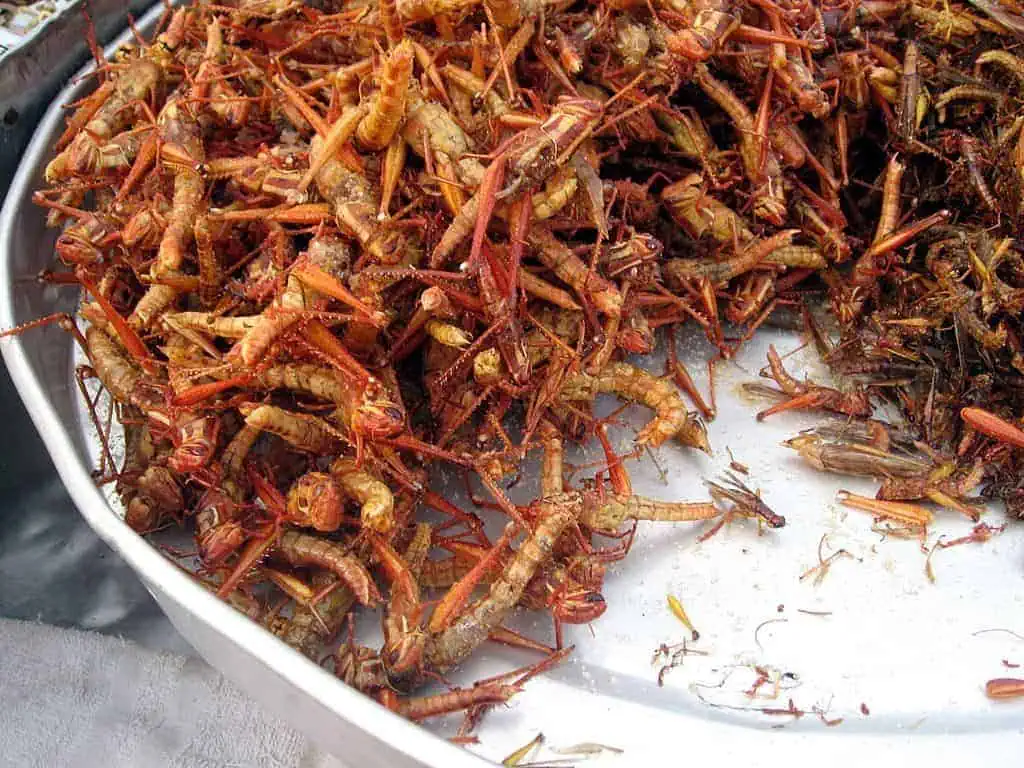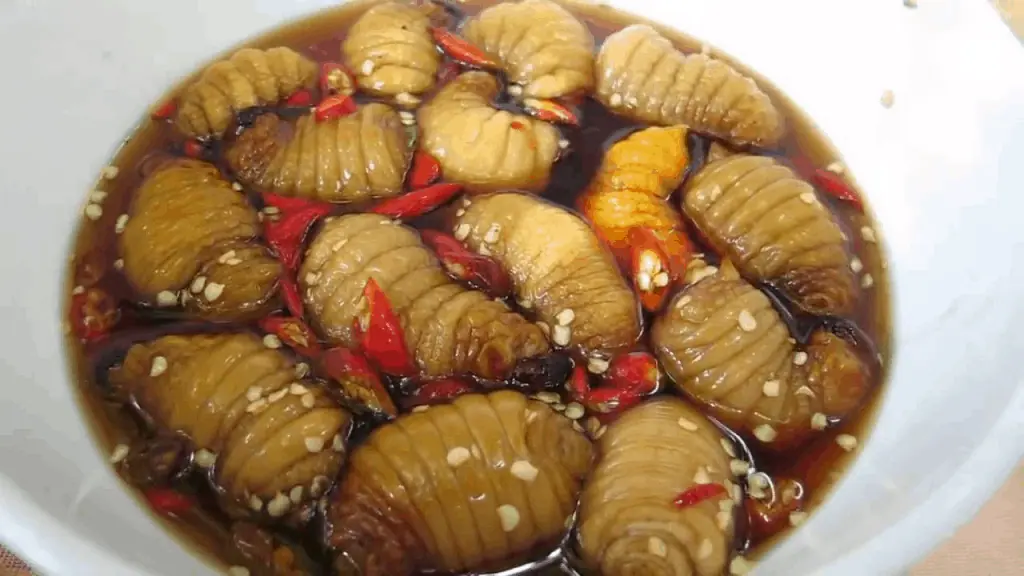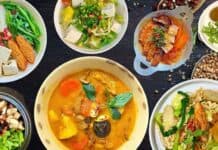Saigon is renowned for its amazing street food culture. Comprising some of the most delectable dishes from all parts of Vietnam, its reputation for having some of the most exotic and weirdest street foods in the world are well earned. However, keep in mind that strangeness doesn’t always equate to disgusting.
If you’re an adventurous eater wanting to know about some of the weird foods in Vietnam on offer, then read on! This article will provide an introductory guide to exotic Vietnamese food and what to expect from some of the strangest street food in Saigon.
Table of Contents:
(Please click on the links below to jump directly to the topic you want to explore)
- Congealed Blood (Huyet)
- Balut/Fertilized Duck Egg (Hot Vit Lon)
- Intestine and Organ Stew (Pha Lau)
- Nails Snails (Oc Mong Tay)
- Grilled Scorpions (Bo Cap Nuong)
- Frog Porridge (Chao Ech)
- Fried Crickets (De Chien)
- Crab Soup (Sup Cua)
- Coconut Worms (Duong Dua)
Congealed Blood (Huyet)

Congealed blood isn’t actually food you would eat by itself or find at a Saigon street food stall, but it is a common ingredient in cooking. This weird food is actually not strange to local palates and is found in many iconic Vietnamese dishes such as Bun Bo Hue, Bun Rieu, and rice porridge.
The cubes of congealed blood soak up the rich flavors of the dish and take on a whole new flavor. Usually made from pig or chicken blood, this jelly-like substance is simply a Vietnamese version of blood sausage or black pudding.
Note: Don’t confuse this food with ‘Tiet Canh’ which is a dish made from raw blood and spices and more common in northern Vietnam.
What does congealed blood taste like?
Congealed blood is usually soft and sometimes a little chewy but its texture can vary depending on the dish it is in and how it has been cooked. Without the added flavors of the dish, it’s actually pretty bland, which is why it is not typically consumed by itself. This is one of those foods that sounds way worse to the ear than it actually tastes.
Balut/Fertilized Duck Egg (Hot Vit Lon)
Balut is a simply a boiled egg – albeit fertilized and contains a developing baby duck at some stage. It’s safe to say it’s one of the more shocking foods in Vietnam and trying to convince most foreigners to give it a try is often a challenge.
The infamous balut, known by its common Filipino and English name, is a seriously strange Vietnamese food but one which every visitor should be encouraged to try. Sometimes referred to as a half-hatched egg, this unassuming snack is far from your standard boiled egg and contains a young duck in its early stages of development. With its associated yolk sack, it is high in calcium, protein and an extremely nutritious snack for Vietnamese. Balut is sold from small stands or carts on the streets of Saigon.
Balut, or “Hot Vit Lon” in Vietnamese, is also found in other places and is often considered the epitome of strange Southeast Asian street food. Luckily there are a few options and stages of development that can make your Vietnamese balut experience a little bit easier to digest:
Hot vit dua
Very early stage with no signs of meat. Inside the egg, the contents are soft and dark yellow, with a rich buttery taste.
Hot vit lon
This stage represents the later stages of development and can vary in consistency and texture. It will have young meat but less yolk, and it contains a hard calcium deposit that can also be eaten
Note: Early feathers, bones and even beaks are sometimes found in a balut but are soft and still edible.
What does balut taste like?
For those who consume meat and eggs regularly, the flavor of the balut is far from offensive. Vietnamese balut eggs are a blend of a subtle and undefined meaty taste combined with a strong yolky flavor. The exact stage of development can sometimes be a gamble even if you request the vendor for a “younger” egg. As the egg develops further, the taste becomes richer. Balut in Saigon is eaten with kumquat juice, salt, pepper and laksa leaves
Intestine and Organ Stew (Pha Lau)

Intestine and organ stew is often referred to, even by English speakers in Vietnam, by the more appetizing name of “Pha Lau”. It comes in two varieties: one is made from stewed beef organs (pha lau bo) and the other and more common variety is made from pork (pha lau long heo).
The key to success in preparing this dish lies in careful portioning and cleaning of the stomach, intestines, heart, kidney, lungs and in the case of pork, the ears as well! These organs are then stewed for hours in a broth made from coconut water, curry powder and a variety of spices.
“Pha Lau” is a Saigon street food specialty and its fragrant aromas make it irresistible to hungry locals. It can be served with rice or noodles but is most commonly accompanied by crispy bread (banh mi) which helps to soak up the stew. Like with many other famous Vietnamese dishes it’s served with a side of kumquat and chili fish sauce to dip the meat in.
What does Pha Lau taste like?
As with many strange and exotic foods, the experience of eating intestine and organ stew is often much better than it may sound initially. Once you can overcome the thought of consuming organs, you are rewarded with tender, chewy, and sometimes crispy slices of meat. The stew itself is rich and possesses a unique flavor that sets it apart from other Vietnamese dishes. Don’t let the initial hesitation deter you from trying this intriguing and flavorful specialty.
Nails Snails (Oc Mong Tay)

If you visit Saigon and don’t spend an evening eating snails and drinking beer, can you truly say you’ve experienced the city? Eating snails is as synonymous with visiting Saigon as iced coffee and is one of the most unique dining experiences in Saigon you shouldn’t miss.
In Saigon, you’ll find numerous common types of snails, but none are as peculiar (yet elegant) as the long and slender fingernail snails, also known as nail snails. These particular snails are exclusive to coastal areas and reside along muddy shorelines, only emerging during high tide. They are larger than other snails, making them easier to eat, and they are highly nutritious.
Once the snails are thoroughly cleaned to remove any sand or grit, they are prepared by grilling, steaming, or stir-frying. Nail snails are often cooked with other common ingredients like tamarind, water spinach, garlic, or lemongrass, which helps diversify the texture of the dish they are served in.
What do snails taste like?
When nail snails are cooked properly, they should maintain their softness and chewiness. However, it’s important not to be put off by the peculiar smell they may emit. The meat of nail snails has a slight sweetness, but it is quite subtle, often overpowered by the flavors of the accompanying ingredients used in cooking. Vietnamese coriander, salt, kumquat juice, black pepper, and fish sauce are common condiments found in Saigon snail restaurants, allowing diners to personalize the taste according to their preferences.
Grilled Scorpions (Bo Cap Nuong)

The sight of a tray load of skewered and grilled scorpions is enough to make some travelers shriek in horror and run away. For others, it stirs their curiosity and represents a challenge to normal and mundane eating habits.
In the past when meat was more of a delicacy and high protein foods were scarce, insects and arachnids would have been more commonly consumed. Nowadays, scorpions are no longer a typical Vietnamese food, and it’s safe to say that most people haven’t tried them.
Despite being incredibly nutritious, you’re definitely not going to find these little stingers served up at your regular eatery. However, there are specialized street stalls and restaurants scattered throughout Saigon that offer them.
The main variety of scorpions you’ll encounter in a dish is a type of giant forest scorpion which is large, black and not lethal for humans. While they are rare in cities they can be found sometimes in horrified abundancy in rural areas of Vietnam. Scorpions can be cooked in several different ways but grilling is the most common method.
What does scorpion taste like?
Grilled scorpion has a mild and subtle barbequed flavor with a hint of nuttiness. Due to their limited amount of meat, they may lack flavor on their own. To enhance the taste, salts, spices, and sauces are often provided at the table for seasoning. The texture of scorpions is incredibly crunchy, which sets them apart from most other foods you may have tried before. It’s a unique culinary experience that can be quite different from the usual fare.
Frog Porridge (Chao Ech)

While frog meat may be the least exotic food on this list, it can still be considered strange for many foreigners. It may not cause someone to recoil in horror, but it can turn them off in a more subtle way.
Rice porridge, known as “chao” or congee, is a common dish eaten at any time of the day. It involves cooking rice with more water than usual until it becomes a thick, soupy consistency. It is often consumed by those who are sick, young, or elderly due to its easy-to-digest nature. However, it can be relatively plain in taste.
Chao ech Singapore has become a popular Vietnamese street food but can also be found at some dedicated restaurants in Saigon. In this dish, the frog meat is marinated in a flavorful sauce made from soy sauce, oyster sauce, onions, and cinnamon wine. It is then cooked and served in a clay pot separately from the rice.
What does frog taste like?
Frog meat, when eaten on its own or with minimal flavoring, has a taste somewhat similar to chicken, but with a unique and exceptional quality. While there are similarities, well-cooked frog meat remains soft and tender, akin to fish, rather than being stringy and greasy like chicken can sometimes be.
If frogs weren’t so small and fiddly to eat they’d probably be much more popular around the world. The sauce used in chao ech Singapore has a very strong Chinese-style flavor that is so delicious you’ll find yourself scraping every last drop from the pot.
Fried Crickets (De Chien)

Crickets and other insects have traditionally been a common part of the diet in rural areas throughout Southeast Asia, although their consumption has become less prevalent in recent times. Typically, they are seasoned and fried just before being eaten. Despite their small size and amount of meat, they are rich in healthy proteins, fats, and vitamins.
Crickets currently remain in the shadows in the amazing Vietnamese street food scene. However, their nutritional benefits, the enviro-friendly farming practices, and the growing interest in unique Vietnamese cuisine among foreigners are starting to generate curiosity and demand for these peculiar foods. As awareness spreads about the benefits of consuming insects, it’s possible that crickets and other edible insects may gain more recognition and popularity in Vietnam’s culinary landscape.
What do crickets taste like?
Crickets are super crunchy with a little salty tang to them. Many diners compare the experience of eating crickets to munching on exceptionally light and crispy potato chips. However, despite their unique characteristics, it may take some time and convincing for crickets and other edible insects to become mainstream in culinary preferences. As people become more open to exploring diverse and sustainable food options, there is potential for crickets to gain wider acceptance and appreciation in the future.
Crab Soup (Sup Cua)

Crab soup is no doubt a truly exotic dish for the majority of tourists and travelers However, it is extremely common and popular as a street food in Saigon. It is often enjoyed for breakfast, dinner, or as a convenient and affordable snack to take away in a cup.
The soup typically consists of a filling chicken-based broth with ingredients such as shredded crab, mushrooms, shredded egg, or tofu. To achieve a thick consistency resembling a gravy, corn or tapioca starch is used as a thickening agent. Additional flavors are added through the inclusion of small quail eggs, soy sauce, and cilantro, enhancing the overall taste of the soup.
What does crab soup taste like?
The flavor of crab soup can be subjective, and while it may not appeal to everyone, it is generally considered to be inoffensive. The subtle taste of crab pairs well with the soy sauce, eggs, and broth, creating a harmonious blend of flavors. However, it’s the texture of the soup, which some describe as mucus-like, that often deters people from fully embracing this exotic Asian dish. If you can overcome the first impression of that texture, you may find that the flavors and overall experience of the crab soup are enjoyable.
Coconut Worms (Duong Dua)

PLEASE NOTE: While you may see coconut worms in Saigon or see people eating them in videos, their consumption is actually illegal. XO Tours do not endorse nor recommend eating coconut worms.
These little slimy critters are one of the more peculiar Vietnamese foods out there and no list of exotic food in Saigon would be complete without it.
The humble Vietnamese coconut worm lives and breeds in coconut palm plantations and feed on essential parts of the trees, which can result in significant damage and even death to the plants. Consequently, the consumption of coconut worms and promoting their proliferation is prohibited.
Although illegal, coconut worms can still be found at many street stalls and rice vendors in Saigon. They can be cooked in several different ways but more commonly found fried, steamed or, for the more adventurous, consumed alive! The worms, still wriggling usually, are simply immersed in a spicy fish sauce and swallowed after a little chewing. Adventurous eating in Saigon at it’s finest!
What do coconut worms taste like?
When eaten raw, the coconut worm taste is overwhelming nutty in flavor and has a soft and fatty texture. Some eaters have described them as “little pods of peanut butter”! When fried, however, the worms tend to lose some of their their distinct flavors and instead absorb flavors from the other ingredients used in the cooking process
We hope this list has been helpful for brave eaters who are interested in exploring the exotic foods of Saigon. It is important to note that while these dishes may be considered strange or unusual to some, they are not necessarily regarded as disgusting in Vietnam. Each dish has its unique flavors, textures, and cultural significance, and trying them can offer a deeper understanding and appreciation of Vietnamese cuisine.
If you’re looking for a fantastic food tour experience in Saigon, check out our world acclaimed “XO Foodie” tour. It has been recognized as one of the top 9 best food tours in the world by Forbes Magazine. While the tour may not include the specific adventurous dishes mentioned in this blog post, it aims to provide guests with an memorable experience in Saigon.
Unlike other food tours that fill their customers up with gluten or starch-based foods, the XO Foodie Tour offers a balanced mix of meat and vegetables. The dishes we serve on the tour are also not the mainstream Vietnamese street food dishes like Banh Mi or Pho, but the most authentic local dishes that travelers don’t usually get to try when they come to Saigon.









